|
|
La Troienne

|
|
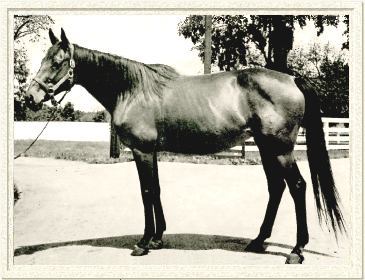 |
|
|
La Troienne emerges in Thoroughbred breeding history as one of the most influential mares to be imported into the U.S. in the 20th century, and as probably the most famous example of how a seemingly worthless mare, summarily culled from her original owner's broodmare band, can turn out to be a bounteous blessing for the person who next possesses her. In the story of La Troienne, the men involved were Marcel Boussac and Edward R. Riley. The former, the most noted breeder in France for over three decades, decided to rid his establishment of a filly he considered unworthy to become a member of his prestigious stud, due to her unremarkable turf career. The latter, one of the most successful breeders of American classic winners, in particular Kentucky Derby winners, seemed to have a knack for purchasing inexpensive European mares, sending them to the warmth of Kentucky and getting them to produce top class runners. La Troienne certainly fit that bill.
La Troienne was bred by Boussac during the formative years of a breeding program which was arguably the most dominant in Europe over the next three decades. With a fortune made from the manufacturing of textiles, Boussac was able to lavish money on Thoroughbreds. He purchased Haras de Fresnay-le-Buffard, situated near the historical little village of Falaise, previously renowned as the birthplace of William the Conqueror. During the 1920s, Boussac collected a large number of mares from France and England, and sent them to the best stallions then standing in France, individuals such as Rabelais and Teddy.
One of the mares purchased by Boussac was Helene de Troie, a filly whose racetrack form had been only moderate, winning once on the flat at two and three times in minor steeplechase events after the age of three. At first glance, her pedigree was not the most fashionable, being by Helicon, a minor stakes winner, out of Lady of Pedigree, an unraced daughter of Princess of Wales's Stakes winner St. Denis, out of Doxa (1901), by Melton. However, Helene de Troie came from a family which had been nurtured by England's Joel family for many years and which had produced three British classic winners between 1913 and 1921: her second dam, the unplaced Doxa was a full sister to Absurdity, who produced the classic winners Black Jester and Jest, and was second dam of Derby winner Humorist. Both Doxa, and her daughter, Lady of Pedigree, ended up in France. Helene de Troie was acquired by Boussac as a three year old, and Boussac sent her to leading sire Teddy twice, getting a stakes-winning colt named Leonidas in 1925, and La Troienne, foaled in the spring of 1926.
|
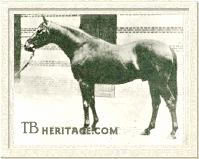
Teddy
| |
Teddy was a product of Edmond Blanc's famed Haras de Jardy. Teddy, foaled in 1913, was sired by Ajax, a Flying Fox colt which captured the classic Prix du Jockey Club during a brief, but undefeated, career. Dam of Teddy was Rondeau, a daughter of Bay Ronald and the Bend Or mare Doremi. Due to the uncertainties of World War I, Blanc sold Teddy, the colt going to American Jefferson Davis Cohn. Teddy raced in Spain, winning six of his eight starts, including the Gran Premio San Sebastian and the Premio Villamejor (Spanish St. Leger), enroute to being named Spain's champion three-year-old.
|
Returned to France for stud duty after the war, Teddy quickly established himself a top stallion, the exploits of his classic-winning son Sir Gallahad III earning him leading sire status in France in 1923, while another son, Astérus, captured the classic Poule d' Essai des Poulains in the spring of 1926.
La Troienne on the Turf
Leonidas possessed a some racing class, capturing the Prix de la Municipalite in France and the Lincolnshire Handicap in Britain. Boussac held high hopes for La Troienne, and from the beginning of her racing career, ran her in the best company.
Unfortunately, La Troienne had none of the talent of her elder brother. Due to her small stature, she was also somewhat delicate, traits she would later pass onto some of her offspring. La Troienne made her debut in the Prix de Sablonville in September 1928. Her home gallops must have shown something, for she started at odds of 4-1. She was unplaced. Raced once more as a juvenile, La Troienne ran far down the course in the Prix d'Arenberg.
La Troienne was sent out the first time at three in the Prix Chloe, going off at odds of 38-1. She performed like the longshot she was, straggling home unplaced. Her dismal record did not seem to deter Boussac, who had no qualms at all about running her in the classic Poule d'Essai des Pouliches. At odds of 31-1, La Troienne made no headway and finished unplaced to the victress Poesie.
Still, Boussac persevered with La Troienne. Despite four unplaced runs, Boussac shipped her to England. The change of climate or racing surface may have had some effect, for though she didn't win any of her British races, her form improved substantially. In Newmarket's five furlong Snailwell Stakes, she ran a decent third. In the Freckenham Stakes, run a month later over seven furlongs, she was beaten for the win by only a length and a half. Her improvement halted there, as in her next and last start, the Welter Handicap at six furlongs, she reverted to her old form and ran unplaced.
After seven starts, with no wins, one second, one third, five unplaced finishes and only the equivalent of $146 in purse money won, La Troienne was retired. Boussac was a strict adherent to keeping only those mares which produced, either on the track or in the breeding shed. Those which failed to do so were culled without a second thought. At the same time La Troienne was toiling hopelessly on the tracks of France and England, Boussac sent the elderly foundation matron Frizette to a French slaughterhouse, despite the fact her daughters had helped make his stud. La Troienne fortunately escaped that fate. Instead, Boussac shipped her back to England in the spring of 1930 and had her covered by Gainsborough. She was a young mare, by a leading sire, from a classic-producing family. In foal to a stallion whose son Singapore was rated one of the best of his age that same year, Boussac hoped to reap some financial benefit from the filly who had singularly failed to redeem herself as a runner for the Boussac stable. Accordingly, La Troienne, and five other Boussac mares, were sent to the Newmarket December sale.
La Troienne was catalogued as hip number 640, one number before fellow Boussac cull Lespedeza, a daughter of Frizette. Both mares were purchased by Dick Thompson, acting on behalf of Edward Riley Bradley, master of Idle Hour Farn near Lexington, Kentucky. La Troienne was the most expensive of the six Boussac mares offered at the sale, going for 1250 guineas. In one of the ironies of genetics, Boussac later bred a three-quarter sister to La Troienne, a daughter of Astérus named Adargatis. A superior performer, she captured the classic Prix de Diane and was retained by Marcel Boussac for his broodmare band. While she foaled two exemplary racehorses in the full brothers Ardan and Pardal, her longterm influence proved to be negligible, with American performers Cornish Prince and Kentucky Derby winner Spend A Buck proving to be two of her most noteworthy descendants.
La Troienne in the Breeding Shed
The purchaser of La Troienne, Edward Riley Bradley, a man who went by the honorary title Colonel, was a gambler by profession and a horse breeder by vocation. Bradley began breeding horses in 1906, and his breeding fortunes took off with the acquisition of yearling colt Black Toney. Many pounds below his contemporaries Old Rosebud and Pennant on the racetrack, Black Toney quickly established himself a first rate stallion when he sired champion filly Miss Jemima in his very first crop of just four foals. Black Toney was a male line descendant of Domino, an intensely inbred (Domino carried three crosses of Lexington in the first four removes of his pedigree), and brilliantly fast champion of the early 1890s who became a hugely successful sire despite his tragic early death.
With his early success for Col. Bradley, Black Toney soon became the premier stud at Idle Hour. For many years, the Colonel followed a practice of mating his mares almost exclusively to Black Toney or his sons and grandsons.
When La Troienne arrived at Idle Hour in early 1931, it was decided to send her to Black Toney. But first she had to drop the foal she was carrying by Gainsborough. In due course she did foal a Gainsborough filly. Tragically, the filly suffered from weakness in her back and hindquarters. This unnamed filly was put down, which at the time seemed no great loss. Years later, Bradley's longtime farm manager Olin Gentry, lamented the loss of that Gainsborough filly. With the benefit of hindsight, Gentry sadly recalled, "The worst thing he ever did was have me destroy the first filly we bred from La Troienne." The sentiment rang all the more true as the years went by, as La Troienne proceeded to found a female family which to date has yielded over 800 stakes winners. She has been called the most important mare ever imported to the United States. Each of her daughters, as well as many granddaughters, great-granddaughters and beyond, founded branches of her family which combined, make the family of La Troienne an influential one in the history of Thoroughbred breeding and racing. |
| PRODUCE RECORD OF LA TROIENNE |
| Year | Name | Stats | Sire | Racing (stakes) | Offspring |
| 1931 | Unnamed | f. | Gainsborough | put down as foal |
| 1932 | Black Helen | f. | Black Toney | Champion at 3 | Dam of Be Like Mom, Hula Hula |
| 1933 | Barren |
| 1934 | Biologist | ch.c. | Bubbling Over | stakes winner |
| 1935 | Baby League | f. | Bubbling Over | winner | Dam of Busher, Striking |
| 1936 | Big Hurry | f. | Black Toney | winner | Dam of Be Fearless, Bridal Flower, Blue Line, No Fiddling, Allemande |
| 1937 | Bimelech | c. | Black Toney | SW at 2 and 3 | Sire of 30 sw |
| 1938 | Big Event | f. | Blue Larkspur | stakes placed | Dam of Blue Eyed Momo, Blackball, Hall of Fame |
| 1939 | Businesslike | f. | Blue Larkspur | non-winner | Dam of Auditing, Busanda |
| 1940 | Besieged | f. | Balladier | -- | Dam of Hook Money, Twitter, Make Tracks |
| 1941 | Broke Even | c. | Blue Larkspur | stakes placed |
| 1942 | Back Yard | ch.c. | Balladier | unraced |
| 1943 | Barren |
| 1944 | Bee Ann Mac | b.f. | Blue Larkspur | SW at 2 | Bred 3 winners |
| 1945 | Belle Histoire | f. | Blue Larkspur | non-winner | Dam of Royal Record, Secret Story, Keep a Secret, Narrative |
| 1946 | Barren |
| 1947 | Belle of Troy | f. | Blue Larkspur | unraced | Dam of Cohoes |
| 1948 | Trojan War | ch.g. | Shut Out | winner |
BLACK HELEN
According to plan, after the birth of her ill-fated Gainsborough filly, La Troienne visited Black Toney, and in the spring of 1932 produced a bay filly who would be named BLACK HELEN. Since she was so tiny, (when full grown she barely topped the scales at 900 pounds and was just a shade under fifteen hands), and since she was out of a mare whose only previous offspring had been destroyed because of severe physical problems, Black Helen was not nominated to any of the important stakes for two-year-olds. But Black Helen proved that looks can be deceiving, as when she went into training with Bradley's second string trainer William Hurley, she proved to have a wealth of talent.
Black Helen emerged as an unexpected star for the Bradley stable as a two-year-old, winning seven of nine races. Re-appearing at Hialeah in late February of 1935, Black Helen took an allowance race. This set her up for a daring run at the colts in the Florida Derby. Bradley, being a betting man, decided to take a shot, and was rewarded for his faith in the tiny filly when she won the race in a canter. Black Helen took the Coaching Club American Oaks over Good Gamble and stablemates Bloodroot and Bird Flower and the American Derby over a fine field of colts as well as the previous years juvenile filly champion Nellie Flag. Black Helen could not handle Triple Crown winner Omaha in the Arlington Classic, finishing fourth, but she later rebounded to capture the Maryland Handicap over stablemate Bloodroot and several colts. In all, Black Helen won 15 of 22 starts and was named champion three-year-old filly of 1935. Her racetrack exploits earned Black Helen induction to the National Museum of Racing and Hall of Fame in 1991.
|
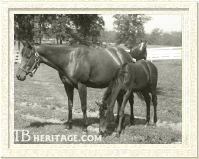
Black Helen and Be Like Mom
| |
Black Helen had a long career as a broodmare, giving birth to her first foal in 1937 and to her last in 1954. It was a severe disappointment that none of her foals won stakes, though she had several winners. Three daughters of Black Helen produced stakes winners, and through them the family of Black Helen has thrived to the present day. Daughter Be Like Mom, a filly by Sickle, was unplaced in two starts as a juvenile, but as a broodmare, foaled three stakes winners--Renew, But Why Not, and Oedipus--all by Blue Larkspur, a grandson of Black Toney.
|
Be Like Mom
Renew, But Why Not and Oedipus were sold after Colonel Bradley died in 1946, which necessitated the dispersal of his breeding and racing stock. The dispersal was handled by a syndicate which had bought Riley's horses from his surviving brother. The syndicate comprised Robert Kleberg's King Ranch, Ogden Phipps, John Hay Whitney's Greentree Stud.
But Why Not went to the King Ranch, and for that stable was champion three-year-old filly and champion handicap mare of 1947. Her victories included the Arlington Classic over Fervent and Cosmic Bomb, the Alabama Stakes, the Pimlico Oaks, the Arlington Matron Handicap, and the Beldame Stakes in which she defeated Miss Grillo. She ran Phalanx to a neck in the Dwyer. Winless at four, she came back at five to capture the Top Flight and Firenze Handicaps and run second in the Suburban Handicap and third in the Metropolitan Handicap. But Why Not's best offspring was stakes winner How Now, by Beau Max.
Oedipus went to the Phipps family. Winless in six starts at two, he was gelded and trained to see what he could do over jumps. The result was a career which saw Oedipus win fourteen races, including two runnings of America's own Grand National Steeplechase Handicap, as well as induction into the National Museum of Racing and Hall of Fame in 1978, the same year he died, aged 32.
Renew, like her sister But Why Not, became a member of the King Ranch stable. Though not of the championship caliber of her siblings, she nevertheless acquitted herself with distinction on the racecourse, winning the Firenze and Top Flight Handicaps and placing in the Gazelle Handicap, Beldame Stakes, Vagrancy Handicap, and the New Castle Handicap. As a producer, her most significant was the Bold Venture filly Refurbish. A winner once in seven starts, Refurbish was the dam of classic-placed Buffle and the third dam of American champion Princess Rooney, heroine of such important events as the Frizette Stakes, the Kentucky Oaks, the Vanity Invitational Handicap, and the inaugural running of the Breeders' Cup Distaff. Princess Rooney became the first Breeders' Cup champion to be inducted into the Hall of Fame when she was enshrined in 1991, joining ancestress Black Helen who was inducted that same year.
Hula Hula
Upon the death of Colonel Bradley, Black Helen was one of the horses who went to Ogden Phipps. The aging mare was moved from Idle Hour to Claiborne Farm, where she produced her last five foals for her new owner.
Hula Hula, a Polynesian filly born when Black Helen was twenty years old. Through Hula Hula's daughter Hula Bend, came Australian Group I winner Hula Drum and champion Hula Chief, full brothers by Marceau. Never Hula, a full sister to Hula Bend, produced Never Knock, a filly by Stage Door Johnny. Never Knock became the dam of American champion Pleasant Tap, winner of the Suburban Handicap and the Jockey Club Gold Cup during his championship season. Never Knock later produced a Cormorant colt named Go For Gin, winner of the Kentucky Derby in 1994 and placed in the Preakness and Belmont Stakes.
Choosy and Resourceful
At Claiborne Black Helen also produced Choosy, by My Request, dam of Pan Zareta Handicap winner Round Pearl, whose daughter, Perla Fina, foaled in 1978, produced stakes winner Electric Flash, and was still an active broodmare well into her twenties in 2001. Resourceful, Black Helen's daughter by Shut Out, was a winner once in two starts. As a broodmare she produced the stakes winner The Ibex and was second dam of Ogden Phipps's Ladies Handicap winner Destro.
Black Helen was humanely put down on August 17, 1957 at the age of 25.
|
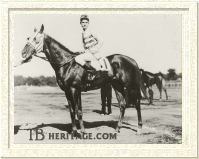
Biologist
| |
BIOLOGIST
La Troienne was barren in 1933, but produced her next named foal in 1934. This was a chestnut son of Colonel Bradley's 1926 Kentucky Derby champion Bubbling Over. The colt, later gelded, was named BIOLOGIST. He never had any pretensions to being top class, in fact, he was a workhorse for the Bradley stable. In four seasons of racing, Biologist faced the starter 41 times and came away with only three victories. One of his victories, though, was in a stakes race, the Albany Handicap, making his dam a stakes producer from her first two foals to race.
|
BABY LEAGUE
La Troienne was bred again to Bubbling Over, and in 1935 produced a full sister to Biologist who was given the name BABY LEAGUE. This filly started eleven times for one win and a mere $1800 in earnings. Baby League earned her way into the broodmare paddocks at Idle Hour by virtue of her pedigree, being a daughter of a Kentucky Derby winner and half-sister to a champion. Any disappointment on the track was more than made up for with her production record. Baby League produced a total of thirteen foals, of which ten started, nine were winners, and four were stakes winners--Busher, Mr. Busher, Striking, and Harmonizing. The first three were full siblings by War Admiral, Harmonizing was by Counterpoint.
|
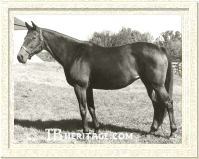
Baby League
| |
For many years, Colonel Bradley harbored an intense aversion to the Fair Play male line, believing them to be too hot-tempered to make them consistently reliable performers. Finally, farm manager Olin Gentry persuaded Bradley to give Man o' War's Triple Crown-winning son War Admiral a try. War Admiral was out of a mare by Sweep, a sire Bradley had respect for and a horse bred very similarly to his own Black Toney, a cross between the blood of Ben Brush and Domino. Baby League was sent to War Admiral, producing the chestnut filly Busher in 1942.
|
Busher
Busher was one of the last champions campaigned in Col. Bradley's green and white silks. She earned a championship as a two-year-old, when she won five of seven starts, including the Adirondack Stakes, Matron Stakes, and the rich Selima Stakes. World War II caused the temporary suspension of racing in the United States from January to May of 1945. Consequently, Col. Bradley sold a good number of his horses in training, Busher included. The champion filly was purchased by Hollywood mogul Louis B. Mayer and shipped cross country to her new quarters at Santa Anita Park. Her price tag was not cheap--$50,000. She swiftly recouped her purchase price, accumulating $273,735 during her second season at the track.
As a three-year-old, Busher swept nearly all before her enroute to being named champion three-year-old filly and Horse of the Year. Her victories included the Santa Susana Stakes, the Santa Margarita, the Cleopatra Handicap, a match race with champion Durazna, the Arlington Handicap, the Beverly Handicap, the Vanity Handicap, and, in perhaps her finest performance, an authoritative victory over Calumet Farm's tough gelding Armed in the Washington Park Handicap. Busher did not race at four, and at five was unplaced in an overnight race. Mayer retired her and later that year sold her to Elizabeth Arden Graham's Maine Chance Farm for $150,000. Busher's exemplary racing career earned her induction into the National Museum of Racing and Hall of Fame in 1964.
Busher had only five foals before her premature death after foaling in 1955. But she produced the good stakes winning Jet Pilot colt Jet Action, her only foal to reach the races. American Grade I winners Beau's Eagle and Favorite Funtime trace to Busher through her daughter Miss Busher, by Alibhai.
Striking
While Busher's contribution to the Baby League branch of La Troienne's family was stunted by her early death, it flourished via the descendants of Striking, Busher's full sister and her junior by five years. Baby League was one of the Bradley horses which went to Ogden Phipps after the death of Col. Bradley, and she was carrying Striking at the time of her transfer to Claiborne Farm.
Striking was a tall, handsome bay filly, quite unlike Busher, who was a small filly like her grandmother La Troienne. However, Striking had only a fraction of her sister's racing ability. During her career, she faced the starter fifteen times, for a record of three wins. She did win the Schuylerville Stakes at two, ran second in the Selima Stakes, Spinaway Stakes, and Marguerite Stakes, and third in the Matron and Pimlico Futurity.
At stud, Striking produced fifteen foals. Of these, there were five stakes winners, including Bases Full and her brother Hitting Away (by Ambiorix), Batter Up (by Tom Fool), Glamour (by Nasrullah), and My Boss Lady (by Bold Ruler). The careers of three of her stakes winners overlapped, and that accomplishment made Striking an easy choice for Broodmare of the Year honors in 1961.
Glamour, foaled in 1954, won the Jasmine Stakes and the Test Stakes. Retired to the Phipps broodmare band, she produced St. Leger winner Boucher, by Ribot, and the Round Table colt Poker, known as the broodmare sire of Triple Crown champion Seattle Slew and dual-classic winner Silver Charm. Glamour's stakes-placed daughter Intriguing, by Swaps, produced the stakes-placed colts How Curious and Cunning Trick, champion filly Numbered Account, and the non-winning filly Playmate. Both Numbered Account and Playmate produced stakes winners; Numbered Account was dam of sire Private Account, and Playmate was the dam of Irish junvenile champion Woodman (1893), an influential sire or champions and sires.
Glamour's sister, So Chic, earned two small victories from eleven starts, but like so many of the fillies in the family, her inadequacies on the track did not hinder her performance as a broodmare. Her offspring included stakes winner Beau Brummel, Kentucky Derby and Preakness Stakes runner-up Dapper Dan, and Adirondack Stakes heroine Fashion Verdict. Broodmare of the Year Prospector's Delite, 2003 American Horse of the Year Mineshaft, and other stakes winners descend from So Chic.
Striking's daughter Bases Full was fourth dam of 2004 Kentucky Derby and Preakness winner Smarty Jones.
The accomplishments of the family of Baby League were still far in the future in the spring of 1935, for when that filly was suckling, her mother La Troienne was again sent to the court of Black Toney. In the spring of 1936 La Troienne foaled a full sister to her champion daughter Black Helen. This was BIG HURRY.
BIG HURRY
Big Hurry was a strongly-made brown filly who possessed none of the precociousness of Black Helen. Trained by William Hurley, who had schooled her elder sister, Big Hurry was first seen under colors in July, 1938. She made five starts that summer, at Empire City, Saratoga, and Belmont Park, before finally breaking her maiden at the latter track in late September. Shipped to Laurel Park in Maryland, she won one of two prep races for the rich Selima Stakes. In the big event itself, Big Hurry closed steadily to defeat Inscoelda by three quarters of a length. Sent against colts for the Pimlico Futurity, she ran well, but could not defeat the colts, coming in fourth. In all, Big Hurry faced the starter ten times at two, and won three, with one second, one third, and $28,810 in earnings. Unfortunately, Big Hurry did not train on at three. She made two starts, failed to win, and was retired.
|
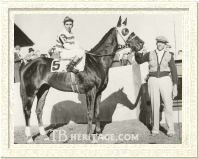
Big Hurry
| |
With sister Black Helen, half-sister Baby League, and La Troienne herself in residence at Idle Hour, Big Hurry was somewhat superfluous. Bradley bred a couple of foals from her and then sold her privately to Ogden Phipps. For Bradley, Big Hurry produced stakes winner Be Fearless, by Burgoo King, that horse's full sister Blue Line, and Bridal Flower, a filly by Challenger II.
|
Bridal Flower
Bridal Flower came about as a result of a rare occasion in which Col. Bradley mated one of his mares to an outside stallion, let alone one who stood as far away as Maryland. But then Challenger II was no ordinary mid-Atlantic based stallion, for he was at the time the sire of Challedon, an American classic winner and Horse of the Year. Later in the decade, his daughter Gallorette would emerge as a champion capable of beating the best horses in training regardless of gender. Bridal Flower was not as rugged physically as Gallorette, rather she took after her "cousin" Black Helen in terms of her small size, yet she had a heart and tenacity which carried her to a memorable career on the track.
Bridal Flower proved to be a decent two-year-old, though never quite up to the task of winning a stakes, but rather getting pieces of the purse. At three, Bridal Flower rounded into form and her campaign saw her named champion three-year-old filly at year's end. She notched stakes wins in the Gazelle Stakes, New Castle Handicap, and a division of the Beldame Handicap. None other than Challenger II's other highly-regarded daughter, Gallorette, captured the other division. Bridal Flower's finest hour at three, though, was a courageous victory over males in the Roamer Handicap. Among her opponents was that season's Triple Crown hero, King Ranch's Assault. The two hooked up with an eighth of a mile left to run, with the filly giving everything she had to defeat Assault by a mere half length.
By the end of the season, Col. Bradley was dead. In the subsequent dispersal, Bridal Flower went to the King Ranch portion of the syndicate handling the Idle Hour dispersal, thereby becoming a stablemate of Assault. At four, she won the Lady Baltimore Handicap and the Westchester Handicap and ran a gallant second to Armed in the Arlington Handicap. As a broodmare for King Ranch, Bridal Flower was a disappointment, foaling a single stakes winner. Her branch of the family has seen a smattering of stakes winners over the years, the most notable being Super Staff, a foal of 1988 and victress in the Grade I Yellow Ribbon Invitational Handicap.
Searching
At the time Bridal Flower was racing, her dam Big Hurry had been sold to Ogden Phipps. For him, she produced three stakes winners--The Admiral, Great Captain, and Searching--all by War Admiral. She also produced a filly by King Cole named No Fiddling. The Admiral was a top notch juvenile, winning the Tremont Stakes and the United States Hotel Stakes before his sudden death at age two. Great Captain was less precocious, but matured into a fine stayer, capturing the prestigious Saratoga Cup.
Searching, born in 1952, was one of the best female handicap runners of the 1950s and became perhaps the most important female descendant of La Troienne by virtue of the family she founded. Trained by "Sunny" Jim Fitzsimmons, Searching raced twenty times as two and three for Phipps without success. Finally, in the spring of 1955 at Belmont Park, Searching was sold. Her purchaser was trainer Hirsch Jacobs, the man who had claimed Stymie for only $1500 and transformed him into a one-time world's leading money earner. Jacobs recalled years later how he acquired Searching. Saddling a maiden in the paddock, he noticed Fitzsimmons and Phipps in the next stall saddling Searching. Intrigued, Jacobs remarked, "Ogden, I see you have another daughter of Big Hurry in here." To which a disgusted Phipps replied, "Yes, and you can have her after the race for $15,000."
It was a scenario oddly reminiscent of Seabiscuit, whom Fitzsimmons had trained for the Phipps family with very little success in the 1930s, only to have him sold and become a multiple champion and national idol for another stable. While Searching did not become either a champion or a national idol, she performed well enough to warrant induction into the National Museum of Racing and Hall of Fame in 1978 and recognition as one of the most important broodmares of her time.
Trained by Jacobs and racing in the name of his wife Ethel, Searching raced through the age of six. In her first season in the Jacobs shedrow, Searching captured the Vagrancy Handicap and the Gallorette Handicap. At four, Searching took the Correction, Diana, Maskette, and Top Flight Handicaps, at five the Gallorette and Distaff Handicaps, and at six the Correction, Diana, Matriarch, and Molly Pitcher Handicaps. A fractured sesamoid ended her career. She earned a total of $327, 381 with a record of 25 victories in 89 lifetime starts. Upon her retirement, Searching was sent to Hagyard Farm north of Lexington.
Her first foal was a handsome dark bay daughter of Swaps who was named Affectionately. During the racing career of her mother, Jacobs carried a picture of Searching in his wallet as a reminder of what a great racemare should look like. Once her daughter started racing, Searching's picture was replaced with one of Affectionately. At two, Affectionately captured the Astoria, Spinaway, Fashion, Polly Drummond, and National Stallion Stakes. At year's end, Affectionately was named co-champion two-year-old on some polls with Smart Deb, victress in the Matron and Frizette Stakes, both over Affectionately.
For the rest of her career, Affectionately was primarily kept to sprints. At three, Affectionately won only the Interborough Handicap, champion honors going to the Bold Ruler filly Lamb Chop. At four, Affectionately added the Correction, Interborough, Sport Page, and Vosburgh Handicaps. At five, Affectionately had her best season, winning the Correction Handicap, the Distaff Handicap under 128 pounds, the Toboggan Handicap over Chieftain and Pia Star, the nine furlong Top Flight Handicap over Steeple Jill and Old Hat, and the Vagrancy Handicap under a staggering impost of 137 pounds. Affectionately joined her dam Searching in the Hall of Fame when she was inducted in 1989. In the stud Affectionately produced the champion colt Personality, by Hail to Reason; sent to stud in Japan, he is seen as broodmare sire of 1990 Canadian Triple Crown champion Izvestia.
In 1962 Searching foaled the first of two fillies by Jacobs homebred champion Hail to Reason. This was Admiring. As a two-year-old, Admiring won the Arlington-Washington Lassie Stakes and placed three other stakes. She was stakes-placed at both three and four. As a broodmare, she produced ten winners, but not for Jacobs. Because of declining health, Jacobs sold many of his horses in a reduction sale in 1966. Admiring was sold for $310,000 to the partnership of Charles Engelhard and Paul Mellon, at the time a world record for a horse sold at public auction. Eventually, Paul Mellon acquired sole ownership of Admiring, and for him she foaled in 1973 a strongly-built, headstrong filly by Graustark named Glowing Tribute, a stakes winner on the grass. Glowing Tribute, Broodmare of the Year in 1993, became the dam of an incredible seven stakes winners, including Hero's Honor; Glowing Honor, like her mother, a winner of the Diana Handicap; Mackie; Coronation Cup; and Kentucky Derby winner Sea Hero, a colt sired by another La Troienne descendant named Polish Navy. The daughters of Glowing Tribute have become successful producers: stakes winners Eastern Echo, Roar, Yell, and European champion Mozart, descend from them. Sire Magesterial and Coaching Club American Oaks winner Lite Light descend from other Admiring daughters.
The second Searching daughter by Hail to Reason was Priceless Gem, born in 1963. Her two-year-old season was one of sheer brilliance, for she not only captured the rich Frizette Stakes but she became only the thirteenth filly to defeat colts in the historic Futurity Stakes, and she did so by defeating the acknowledged king of that season's two-year-old colts, Ogden Phipps's Buckpasser, like Priceless Gem a female line descendant of La Troienne.
For the Jacobs family, Priceless Gem produced as her first foal a filly by Sea-Bird. This filly was sold as a weanling in the autumn of 1971 for a reported $160,000 to French art dealer and horse owner Daniel Wildenstein. The filly was named Allez France, and during her career became the toast of France, winning thirteen races from eighteen starts in France, twelve Group races, eight of which were Group I, and five championships. Her wins included the classic Prix de Diane, Poule d' Essai des Pouliches, and the Prix Vermeille at three, and the Prix de l'Arc de Triomphe at four. Sadly, Allez France had a difficult career in the broodmare paddocks, foaling a dead Secretariat colt in her first year. She eventually produced French Group winner Action Francaise before her death in a paddock accident at the age of nineteen in 1989.
In addition to Allez France, Priceless Gem produced New Zealand leading sire Noble Bijou to the cover of Vaguely Noble; Lady Wimbourne, destined to become the dam of major winners Al Mamoon and La Gueriere to the cover of Secretariat; and Priceless Countess, a full sister to Noble Bijou and dam of American Champagne Stakes winner Ordway.
No Fiddling
Searching was not the first filly Jacobs obtained from Phipps who turned out to be a goldmine. The first was another daughter of Big Hurry, sired by King Cole, named No Fiddling, whom Jacobs claimed as a two-year-old in 1947 for $7500. This granddaughter of La Troienne retired with no success in eighteen lifetime starts. At age seventeen she foaled a sturdy, handsome bay filly by Hail to Reason in 1962, named Straight Deal. She raced through the age of seven, running 99 times. Of these races, she won 21 and placed in 30 others. Her wins included thirteen stakes races, among them the Spinster Stakes, Delaware Handicap, Ladies Handicap, Hollywood Oaks, and Top Flight Handicap. Six of her stakes wins came at the age of five when she was voted champion handicap mare. Despite the hard racing, as a broodmare, she produced ten foals, eight of which were winners, with three stakes winners. Her Grade l-winning daughter Desiree foaled a Grade I winner in the Seattle Slew filly Adored. Straight Deal was also second dam of stakes winners Commemorate, Premiership, and Belong to Me. Horses descending in tail-female from No Fiddling include Millionaire gelding Royal Glint, Irish St. Leger winner Turgeon (by Caro), Breeders' Cup Turf winner Tikkanen (by Cozzene), and co-champion junveile filly Regal Gleam and her Nijinsky II son Caerleon, the latter 1983 champion three-year-old in France and sire of numerous champions in Europe.
Dashing By
Big Hurry's daughter Dashing By, by Menow, was a decent winner of eight races. After the death of Col. Bradley, his longtime farm manager Olin Gentry remained to keep managing the property after much of it was purchased by John W. Galbreath and renamed Darby Dan Farm. Gentry obtained a daughter of Dashing By, a filly named Stealaway, who was stakes-placed as a runner. Bred to Galbreath's Kentucky Derby and Belmont Stakes champion Chateaugay, she foaled a tough, high class campaigner named True Knight. During his career, True Knight captured nine stakes, including the Amory L. Haskell Handicap, and the Suburban Handicap, both Grade I events. A full sister to Stealaway, Chicken Little, became the second dam of Zoman, a rugged chestnut son of Affirmed who won Group races in France, Ireland, Scotland, England, and the United States. It was sad for breeders that Zoman proved sterile and True Knight, though a fertile stallion, failed to sire anything of consequence.
Allemande
Allemande was the last foal produced by Big Hurry, foaled when that mare was nineteen. Sired by classic winner Counterpoint and foaled in 1955, Allemande inherited some of the soundness problems of her sire and consequently never raced. She paid her way into the Phipps broodmare band as the dam of Marking Time, a To Market filly who captured the semi-classic Acorn Stakes for Phipps in 1966. Utilizing two different patterns in the same mating--crossing a Black Toney line mare from the family of La Troienne (Marking Time) with another female line descendant of La Troienne(Buckpasser), Ogden Phipps came up with another champion in a sugarcube-loving bay mare named Relaxing.
Raced initially in Great Britain, Relaxing was returned to US soil as a four-year-old. After placing in some turf stakes, she found her best form on the dirt and rounded out the season with wins in the Firenze Handicap and the Gallant Fox Handicap, in the latter thrashing males over 1-5/8 miles in record time. At five, "Sugar Mouth," the nickname she earned around the barn because of her propensity for sweet treats, blossomed, earning championship laurels as the nation's best older mare. Her victories included the Delaware Handicap and Ruffian Handicap, and the John B. Campbell and and Assault Handicaps over males. Relaxing also ran a huge third to champion gelding John Henry in the Jockey Club Gold Cup.
Like so many La Troienne tribe members before her, when she went to stud, Relaxing founded a mini dynasty of her own. From twelve foals, she produced three stakes winners--Easy Goer (by Alydar), Cadillacing, and Easy Now--each of whom won at the Grade I level. For 1989, the year her son Easy Goer captured six Grade I stakes, Relaxing was named Broodmare of the Year. Stakes winners Cat Cay, Strolling Along (a shuttle sire to Australian, who died at age five), and 2001 CCA Oaks winner Tweedside (by Thunder Gulch) also descend from Allemande.
BIMELECH
Following the birth of Big Hurry, La Troienne was mated for the last time to aging Black Toney. The stallion was then twenty-five-years-old. Bradley wanted nothing more than a good colt out of La Troienne from his beloved Black Toney. In the spring of 1937 he got his wish, for La Troienne gave birth to a fine dark brown colt. In fact, this was the last colt ever sired by Black Toney, who died when his last-born son was only a yearling. The colt's name was BIMELECH, and during his racing career, Bradley proclaimed him at least the equal if not better than his personal favorite, champion Blue Larkspur.
|
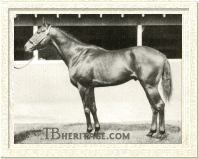
Bimelech
| |
Bimelech drew lavish praise from Joe Estes, who proclaimed, "It is a pleasure simply to walk around that horse, for he is a study in perfection, and one gets from him the same lifting of the spirit that comes from the contemplation of some masterpiece of the fine arts." The colt was named in honor of Col. Bradley's longtime friend John F. Harris, who went by the nickname "Bimelech," a shortened form of the Biblical "Abimelech." Like his elder sisters Black Helen and Big Hurry, Bimelech was conditioned by William Hurley.
|
As a juvenile, Bimelech faced the starter six times and was never beaten. He took the Saratoga Special, and the Hopeful Stakes at Saratoga, the Futurity Stakes at Belmont Park, and the Pimlico Futurity. For Bradley, his colt's victory in the Belmont Futurity was especially satisfying. The famed breeder had been trying to win that event since he ran his first runner in it in 1913. Such great Bradley colts as Blue Larkspur, Burgoo King, and Balladier had tried and failed to bring the Futurity trophy home to Idle Hour.
Such a brilliant campaign made Bimelech an overwhelming favorite to not only win the Kentucky Derby, but the Triple Crown, as well. The colt was kept at Idle Hour over the winter, preparing for his sophomore campaign over the farm training track. However, the winter of 1939/40 was a hard one and Bimelech's training was often interrupted by the inclement weather conditions. Shipped the short distance to Keeneland in late April for the Bluegrass Stakes, Bimelech won easily, with the good colt Roman among the beaten. The ease of his victory gave his connections a case of over-confidence, and consequently Bimelech was sent to run in the Derby Trial only a week before the Derby. Though he won the race impressively, it was a case of the colt using too much of himself in his two Derby preps in combination with a lack of full conditioning. In the Derby itself, the rank outsider Gallahadion romped away from the Bradley champion. Bimelech redeemed himself in the Preakness, with Gallahadion third, finished second in the Withers, then captured the Belmont Stakes, with Gallahadion a bad fifth. After another loss in the Arlington Classic, Bimelech suffered an injury prior to Saratoga and was out of action for the rest of the season. His four-year-old campaign was limited to just two starts before physical ailments forced his retirement.
Sent to Idle Hour to pick up the mantle of his sire Black Toney, Bimelech proved himself a worthy successor, siring thirty stakes winners, including Better Self (himself a sire of some note), Bimlette, and Be Faithful. Daughters of Bimlech produced 49 stakes winners, including Find, Porterhouse, and Lalun, in turn the dam of prominent sire Never Bend. Sold to Greentree Stud after the death of his owner, Bimlech lived to the age of 29, dying on July 21, 1966. He was inducted to the National Museum of Racing and Hall of Fame in 1990, one year prior to his older sister Black Helen.
BIG EVENT
Following Bimelech, La Troienne was sent to the court Black Toney's grandson Blue Larkspur for the first time, and in 1938 foaled a filly who was given the name BIG EVENT. Her career as a runner was moderately successful, for she won two of nine starts during two seasons and managed a second in the Selima Stakes. As a broodmare, Big Event did not match the exploits of Big Hurry or Baby League and did not have the litany of major stakes-winning descendants of her two half-sisters. Big Event had a quiet broodmare career for the first several years. Only one of her foals produced for Col. Bradley, the War Admiral filly Blue Eyed Momo, possessed any significance. Blue Eyed Momo won only race, but became the dam of Francis S., a Royal Charger colt who was one of the better three-year-olds of 1960 with victories in the Wood Memorial and Dwyer Stakes. Francis S. proved a useful sire, but was more noteworthy as the broodmare sire of Futurity Stakes winner Ogygian and champion filly It's In The Air.
|
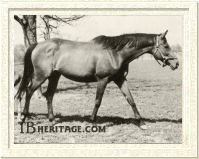
Big Event
| |
After the breakup of the Idle Hour stock, Big Event went to Greentree Stud, and for the Whitneys produced two stakes winners by their homebred classic champion Shut Out. The elder of the two Shut Out siblings was the gelding Hall of Fame, winner of the Arlington Classic and American Derby. Two years his junior was the unraced filly Blackball, dam of two runners of the highest class, The Axe II and Malicious.
|
The former, by Mahmoud, raced first in England, winning the Newmarket Stakes and the Imperial Stakes, before returning to the United States to capture such important fixtures as the Man o' War , Arcadia, and San Luis Rey Handicaps as well as the Canadian Championship Stakes. As a sire for Greentree, The Axe II was responsible for many good stakes winners, including Al Hattab (broodmare sire of Horse of the Year Holy Bull); Hatchet Man (broodmare sire of Kentucky Derby winner Strike the Gold); and Executioner.
The second high class runner out of Blackball was Malicious, a chestnut colt by Helioscope. The resume of Malicious included victories in the Jim Dandy Stakes, Nassua County, Assault, and Stymie Handicaps. As a sire, Malicious came up with several winners, but nothing approaching the class of some of the offspring of his half-brother The Axe II.
BUSINESSLIKE
La Troienne was mated again to Blue Larkspur, and the result was another filly, born in the spring of 1939 who was named BUSINESSLIKE. Though this filly had no racing talent whatsoever, failing to even earn a check in but two lifetime starts, she made a huge contribution to her family through one of her daughters and one of that daughter's sons.
Businesslike was very nearly lost while her dam was carrying her. For several years since her arrival to Idle Hour, La Troienne had suffered from an eye disorder called periodic ophthalmia. The disease settled in her right eye, and eventually she went blind in that eye. The handicap did not affect he until one dark, stormy night in November of 1938. Then, during the violent storm, the frightened mare became confused and crashed into a tree. The impact was so forceful the skin and muscles were torn loose from her right shoulder. Only the most dedicated care enabled La Troienne to recover from the horrible injury. A plain looking mare under the best of circumstances, the scars left by her encounter with the tree did nothing to improve her looks. For the rest of her life, the bones of her shoulder blade were plainly visible under the skin. From then on, La Troienne could only be photographed from the left side. But no matter how bad she looked, Bradley spared no expense in her care. She was treated with every consideration, even given a paddock to herself, which she shared with her foal and some cows for company.
Busanda
Businesslike produced two stakes winners, Auditing and Busanda. It was the latter who was the link between her dam and succeeding generations of this branch of La Troienne's family tree. Businesslike was one of the mares Bradley sent to War Admiral, and in foal to that stallion, she went to Ogden Phipps upon the death of Col. Bradley and the dispersal of his stock. The foal she dropped in the spring of 1947 was a black filly who was given the name Busanda, the Navy acronym for Bureau of Supplies and Accounts, Phipps having served in that branch of service during World War II.
Busanda was a filly of extraordinary ability--when she felt inclined to display it. She was moody and unreliable in her performances, characteristics of the Fair Plays which made Bradley reluctant to use stallions from that line. Busanda was also a throwback to her Fair Play heritage in terms of size, for she was a coarse, rugged mare, quite unlike many members of the La Troienne tribe. Busanda was devoid of any juvenile precociousness. As a juvenile, trainer James Fitzsimmons sent her out twelve times, for one win. Not believing in keeping his horses in cotton wool, Fitzsimmons ran Busanda fifteen times the next year at three, where she recorded two victories including the Alabama Stakes.
At four, Busanda was out 23 times, for five wins. She picked her victories in exceptionally sweet spots, for she took the historic Suburban Handicap, the New Castle Handicap, the Top Flight Handicap, and the Saratoga Cup. At five, she was out fifteen times, for only two victories, but her two wins came in the Diana Handicap and a second running of the Saratoga Cup.
Busanda foaled a stakes winner with her first foal, the Polynesian gelding Bureaucracy. Later came Bupers, a Double Jay colt which captured the Futurity Stakes. Sent to the Whitney family's Greentree Stud to be covered by champion Tom Fool, the result was a magnificent bay colt whom artist Richard Stone Reeves proclaimed to be a horse of nearly faultless conformation. This colt, foaled in 1963, was Buckpasser, one of the best North American champions of the second half of the twentieth century and one of the most influential sires of broodmares, as well.
During his career, Buckpasser won 25 of 31 starts and nearly $1.5 million in earnings. He was unplaced only once. He was the dominant juvenile colt of 1965, winning such prestigious events as the Champagne, Hopeful, Sapling, and Tremont Stakes. He narrowly lost the historic Fururity to the gutsy filly Priceless Gem, like himself, a third generation female line descendant of La Troienne. Kept out of the classics the next spring due to injury, the Ogden Phipps colorbearer still earned championship honors as the best three-year-old colt and Horse of the Year with victories in the Arlington Classic, American Derby, Brooklyn Handicap, Travers Stakes, Woodward Stakes, and Jockey Club Gold Cup. At four came further victories in the Metropolitan and Suburban Handicaps. Between the latter part of his three-year-old season and the first half of his four-year-old season, Buckpasser possessed a fifteen race win streak, a streak which was broken by another La Troienne female line descendant, Poker. Buckpasser earned induction into the Hall of Fame in 1970, only three years after his retirement from racing.
At stud, Buckpasser excelled as a sire of fillies, his three American champions all being of the fairer sex: Numbered Account, Relaxing, and La Prevoyante. The former two were each out of La Troienne line mares, making them inbred to La Troienne 4x5 and 4x4, respectively. Silver Buck, Balzac, State Dinner, English One Thousand heroine Quick as Lightning, and Canadian champion colts Norcliffe and L'Enjoleur were other superior runners to represent their sire. He was broodmare sire of a host of top horses, among them Easy Goer, Miswaki, Private Account, Seeking the Gold, El Gran Senor, Wavering Monarch, Slew o' Gold. He was the sire of two Broodmare of the Year winners, Toll Booth and Relaxing, and broodmare sire of yet another in Weekend Surprise.
Busanda, prior to Buckpasser's birth, had been bred several times to imported Nasrullah. None of those offspring had any racing talent, but two of them, the fillies Finance and Oak Cluster, became heads of their own branches of the La Troienne-Businesslike-Busanda family. Finance's daughter La Mesa, by Round Table, foaled champion filly Outstandingly (by Exclusive Native) and her three-quarter sister, La Affirmed (by Affirmed). La Affirmed, a winner of but one race, has produced three stakes winners and is the second dam of Hopeful Stakes winner and promising young stallion Sky Mesa. Oak Cluster is ancestress of American Grade I winners Slendid Spruce and Officer, the latter currently embarking on his stud career, and also of multiple South African champion mare Splendid Ann.
The last noteworthy offspring of Busanda was the non-winning Navsup, a daughter of Argentinean import Tatan. She produced to the cover of Danzig the top runner Polish Navy, winner of the Cowdin and Champagne Stakes at two and the Woodward Stakes at three. As a stallion he initially suffered from standing alongside his sire at Claiborne Farm. But he did sire a Kentucky Derby winner in the colt Sea Hero, whose dam was Glowing Tribute.
Busanda's half-sister, His Duchess, a daughter of Blenheim II, was fourth dam of the gallant chestnut gelding, Prairie Bayou. At the age of three, Prairie Bayou won the Preakness Stakes and three other stakes, and second in the Kentucky Derby to kinsman Sea Hero. He was named champion three-year-old posthumously, for he suffered a fatal breakdown during the running of the Belmont Stakes.
Busanda died unexpectedly shortly before Christmas 1969 at the age of 22 from a ruptured uterine artery. Tragic as her death was, it was all the more so given the fact she was carrying a full sibling to Buckpasser at the time.
BESIEGED
Foaled in 1940, BESIEGED was La Troienne's first foal from Balladier, a son of Black Toney which had been a crack two-year-old in 1932 but whose career was hampered from soundness problems inherited from his maternal grandsire, North Star III. Besieged raced only four times for one win. Eventually she wound up as a broodmare at John A. Bell's Jonabell Farm. Besieged was dam of Hook Money, a minor stakes winner in England and Make Tracks, a son of Eight Thirty who was exported to Argentina where he did very well as a sire, figuring prominently on the Argentine general sire list several times and leading the broodmare sire list there five times.
|
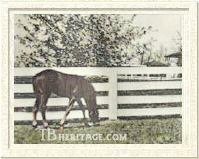
Besieged as a foal
| |
Besieged's daughter Twitter, by Brookfield, became the head of a family which over the years has included stakes winners Aglimmer, Forest Glow, Nasty and Bold, and Pembroke. Besieged, like her mother, developed eye problems and eventually went totally blind. She died in 1962.
|
In 1941, La Troienne foaled a colt by Blue Larkspur. Named BROKE EVEN, he was stakes placed and later became a sire of little renown, with but one stakes winner to his credit. In 1942, La Troienne foaled another colt, a chestnut son of Balladier, later gelded, named BACK YARD. He never raced. In 1943 La Troienne was barren. She was sent to Blue Larkspur again, and in the spring of 1944 foaled a bay filly named BEE ANN MAC.
BEE ANN MAC
Bee Ann Mac became her dam's fifth and final stakes winner when she captured the Selima Stakes at age two. In two years of racing, Bee Ann Mac won two of thirteen starts, and at age three she placed third in the Alabama Stakes won by her "cousin" But Why Not. In the dispersal of the Idle Hour horses, Bee Ann Mac had gone to King Ranch, as had But Why Not, so the two fillies ran as stablemates in the Alabama.
|
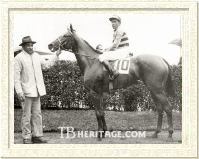
Bee Ann Mac
| |
As a broodmare, Bee Ann Mac produced ten foals, of which only three were winners. Like her half-sister Black Helen, she failed to produce a stakes winner and there have been only a few stakes winners of any quality descended from her.
|
BELLE HISTOIRE
In 1945, La Troienne produced another daughter of Blue Larkspur named BELLE HISTOIRE. In 1946 Belle Histoire and La Troienne, the latter again in foal to Blue Larkspur, were allotted to Greentree Stud by the syndicate which handled the dispersal of the Bradley stock. Belle Histoire raced a total of three times, but failed to win a single race. Later, Belle Histoire was acquired by Wheatley Stable, for whom she produced one stakes winner, a son of Nasrullah named Royal Record whose victories included the Seneca, Bowling Green, and Longfellow Handicaps. Royal Record spent his stud career first in England and then in Japan.
A daughter Secret Story, by Spy Song, became the dam of juvenile stakes winner Catullus (later a sire of several champions in Puerto Rico) and stakes-winning gelding No Turning, by Never Bend. A full sister to No Turning, Keep A Secret, became the second dam of Tejano, a Caro colt foaled in 1985 who became one of the top juvenile performers of his generation by virtue of victories in the Hollywood Futurity, Arlington-Washington Futurity, and Cowdin Stakes, all Grade I events.
Narrative, Belle Histoire's unraced daughter by War Relic, produced Test Stakes winner Brave Pilot and Miss Woodford Stakes winner King's Story, by Bold Ruler. The latter, bred to Australian import Sky High II, foaled a late-developing chestnut colt named Autobiography. Sold by Wheatley Stable to Sigmund Summer, Autobiography went on to become American champion older male in 1972, his biggest win coming in the Jockey Club Gold Cup. Sadly, Autobiography was killed in a race at Santa Anita the following winter.
BELLE OF TROY
La Troienne, who did not produce a foal in 1946, was mated for the last time to Blue Larkspur shortly before Col. Bradley's death. In the dispersal of the Bradley horses, she was, despite her age, the gem of the whole lot, and she went to the Whitney family's Greentree Stud. For them, in the spring of 1947, she foaled yet another Blue Larkspur filly, which in keeping with the old Bradley tradition of naming all horses names beginning with the letter "B" was named Belle of Troy.
|
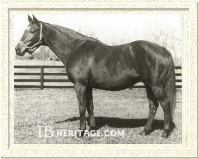
Belle of Troy
| |
Belle of Troy was unraced, but performed admirable service for Greentree as the dam of their homebred stakes winner Cohoes a Mahmoud colt who won major stakes each year he raced, including the Grand Union Hotel Stakes at two, the Saranac Handicap at three, and the Brooklyn and Sysonby Handicaps and Whitney Stakes at four. Cohoes was a successful sire, his son Quadrangle captured the Belmont Stakes; son Shadow Brook became a champion steeplechaser; and daughter Miss Swapsco, a winner of the Ashland Stakes, became the dam of the marvellous producer Ballade, whose family includes Glorious Song, Devil's Bag, Saint Ballado, Rahy and Singspiel.
|
The family of Belle of Troy has been quite active over the decades, producing several top class stakes winners, including Hollywood Gold Cup winner Super Diamond, Del Mar Oaks heroine Bail Out Becky, Hollywood Gold Cup winner Cutlass Reality, Green Peace, a champion colt in Mexico, and Seldom Seen Sue.
Two young stallions currently residing in Kentucky trace to Belle Of Troy--Travers Stakes champion Ten Most Wanted and multiple graded stakes winner More Than Ready.
DECLINING YEARS AT GREENTREE
When La Troienne was sent to Greentree, she was twenty-years-old and her best producing years were long behind her. After foaling Belle of Troy, her retirement was considered, but the Whitneys had the desire to try and get their own foal out of her. Consequently, the old mare was bred to Shut Out, and in the spring of 1948 La Troienne produced a chestnut colt who was named TROJAN WAR. Alas, La Troienne's last-born was not noteworthy for anything except an adventuresome personality as a youngster. The story goes that on one stifling summer day as the mares and foals were being led to their paddocks, La Troienne's little son broke ranks and decided to explore the inside of one of the stable offices, the door having been left open to catch what little breeze there was. The errant colt was soon caught, while his dam merely waited patiently outside the door. Once re-united, mother and baby resumed their trek to the shade of their paddock. Trojan War was gelded before his racing career began, a career in which he ran over sixty times for only two victories.
Following the birth of Trojan War, La Troienne was retired from breeding and allowed to live out her days in the peaceful lushness of Greentree's pastures. During her last years, the famous old mare received a good many visitors, people curious to see the plain little French mare who had become the most celebrated broodmare of her time. Finally, on January 30, 1954, La Troienne, aged 28, was humanely put down. She was laid to rest in the lush, tree-shaded Greentree equine cemetery, not far from the final resting places of some of Greentree's most celebrated horses; Twenty Grand and his dam Bonus, St. Germans, Easter Hero, and Jolly Roger.
In the half century since her passing, La Troienne's influence has strengthened with each succeeding generation. There have been twenty American champions tracing directly to her, as well as champions and classic winners in England, France, Canada, Ireland, Mexico, Australia, and South Africa. Seven American classic winners descend from her. Four recipients of the Kentucky Broodmare of the Year award--Striking, Relaxing, Glowing Tribute, and Prospector's Delight--hail from her family. Two of her own offspring plus seven other horses descending from her in the female line are now enshrined in the Hall of Fame. She was called the most important broodmare to be imported to America in the twentieth century, an acclamation which was made decades ago. In the years since, the importance of her descendants make that observation all the more appropriate now.
-- Liz Martiniak |
|
|
|

